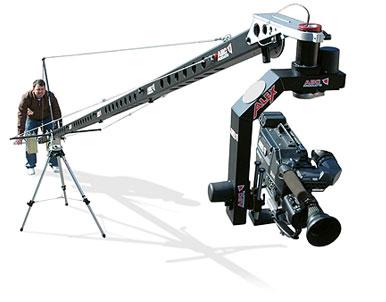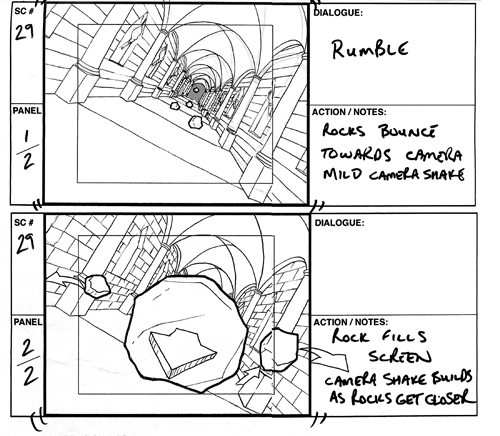| The Moving Image and Problem Set | |
|---|---|
| Course | Arch 200c |
| Date | 2014/11/13 |
| Learning Objectives | A problem set on visualization and a discussion of the role of the 'moving image' in architectural representation. |
| Agenda |
|
| Uses Tool(s) | |
Problem Set
A link to our problem set exercise will be posted here at the start of class.
Save your final rendering as a JPG file , named FIRSTNAME_LASTNAME.JPG , and attach it to an email to the following email address: upload.PS3.j7gmu3434q@u.box.com
The Moving Image
Introduction to Camera Techniques
As a basis for this each animation particular attention will be paid to the relationship between specific camera techniques and the conceptual framework of the film/animation. Each person will choose two specific camera techniques from a list of seven to use in their animation.
- 1. Pan
- In pan shots the camera moves in a smooth horizontal motion from left to right, like a panorama.Always start on a still shot, begin movement, and finish on a still shot. Panning shots are great for panoramic views and scenery. Panning is also good for following a subject or to show the distance between objects.'
- 2. Tilt
- Tilt is like pan, turned 90 degrees, the camera moves up or down without raising its position. With a tilt, you can also show how high something is. When you tilt up and shoot an object it looks larger and thicker. The subject looks smaller and thinner when you tilt down. Start on a still shot, begin the tilt, and finish on a still shot.
- 3. Pedestal
- Not tilting, but physically moving the height of the camera up or down. You pedestal the camera up or down to get the height you prefer. If you want to get "eye to eye" with a six-foot-six basketball player, you would pedestal up. While shooting a flower or a small child, you would pedestal down to their level.
- 4 Dolly
- The camera is set on tracks or wheels and moved towards or back from a subject. Dolly is used to follow an object smoothly to get a unique perspective. A dolly does not necessarily have to follow a straight line, it could also follow a curved pathway.
- 5. Crane
- Crane works and looks similar to a construction crane. It is used for high sweeping shots or to follow the action of your subject. It gives a bird's eye view and looks as if the camera is swooping down from above. Movie directors use this for street scenes so they can shoot from above the crowd and the traffic, and then move down to eye level.
- 6. Zoom
- On a physical camera you press a lever or rocker to zoom in or out. This lever controls the lens mechanism inside the camera and zoom speed can be controlled. Usually, the harder you press on the lever the quicker the zoom. Zoom is used to bring objects at a distance closer to the lens, or to show size and perspective. Start on a still shot, then zoom smoothly, and end your zoom on a still shot.
- 7. Rack Focus
- Focus on one object, like a building, and have everything behind it out of focus. Then adjust the focus so the building becomes blurred and the scene behind becomes clear. In this movement, you are changing the focal length so that one subject will go out of focus while the other comes into focus. The two subjects must be at a correct distance from each other and from the camera for this shot to work.
Animation Screenings + Short Discussions
Several short animation/film screenings and discussions are intended to set the stage for what is possible and help us think outside of the typical architectural fly through animation. Each discussion should address how specific camera, graphic, and lighting techniques contribute or detract from the overall theme.
- Royal Re-Formation by Factory Fifteen
- Local Code / Real Estates by Nicholas de Monchaux
- Wings of Desire (clip), The Accident – Wim Wenders
- A Series of Uncanny Events – Vidhya Pushpanathan, Student AA
- Kahn’s Exeter Short Film – The Third & The Seventh
- Citizen Kane – Orson Wells
- High Line Design Video – Diller Scofidio + Renfro, Video by Brooklyn Digital Foundry
- Museum Plaza – OMA, Video by Brooklyn Digital Foundry
Storyboards
Storyboards are graphic organizers in the form of sketches or images displayed in sequence for the purpose of pre-visualizing a motion picture, animation, motion graphic or interactive media sequence. Storyboards notate camera views/moves, spatial relationships, lighting, process, etc. Each animation project should start with a rough storyboard as a way to begin to organize your ideas. The storyboards will be developed along side each animation.
Storyboard Iteration 1
- Short project statement. What relationships are you trying to show? What is your approach to site and architectural occupation?
-
5 quick sketches (frames) of key views that include
- Camera technique (it may be still)
-
Animation components - if present and in what way
- Site
- Architectural occupation
- Temproal site force
- Quick notation of what is going on
Related
- Analogous 2013 Session
- The above content roughly corresponds with this class session from last year.
- Analogous Summer Session
- The above content roughly corresponds with this class session from last Summer.
- A Similar Problem Set
- Here is a similar problem set.
- A Similar Problem Set
- Here is a similar problem set.
- A Similar Problem Set
- Here is a similar problem set.
- A Similar Problem Set
- Here is a similar problem set.
- A Similar Problem Set
- Here is a similar problem set.





